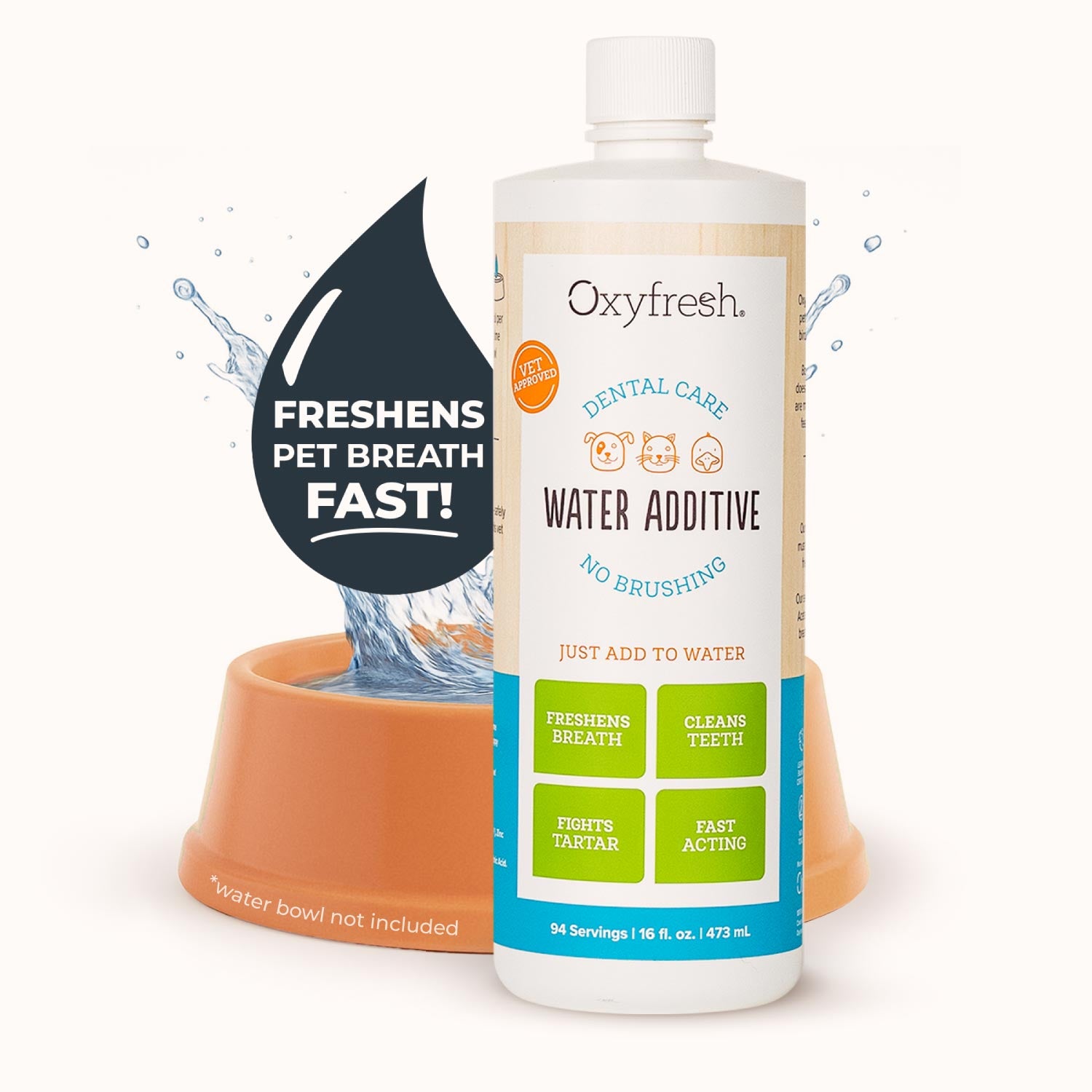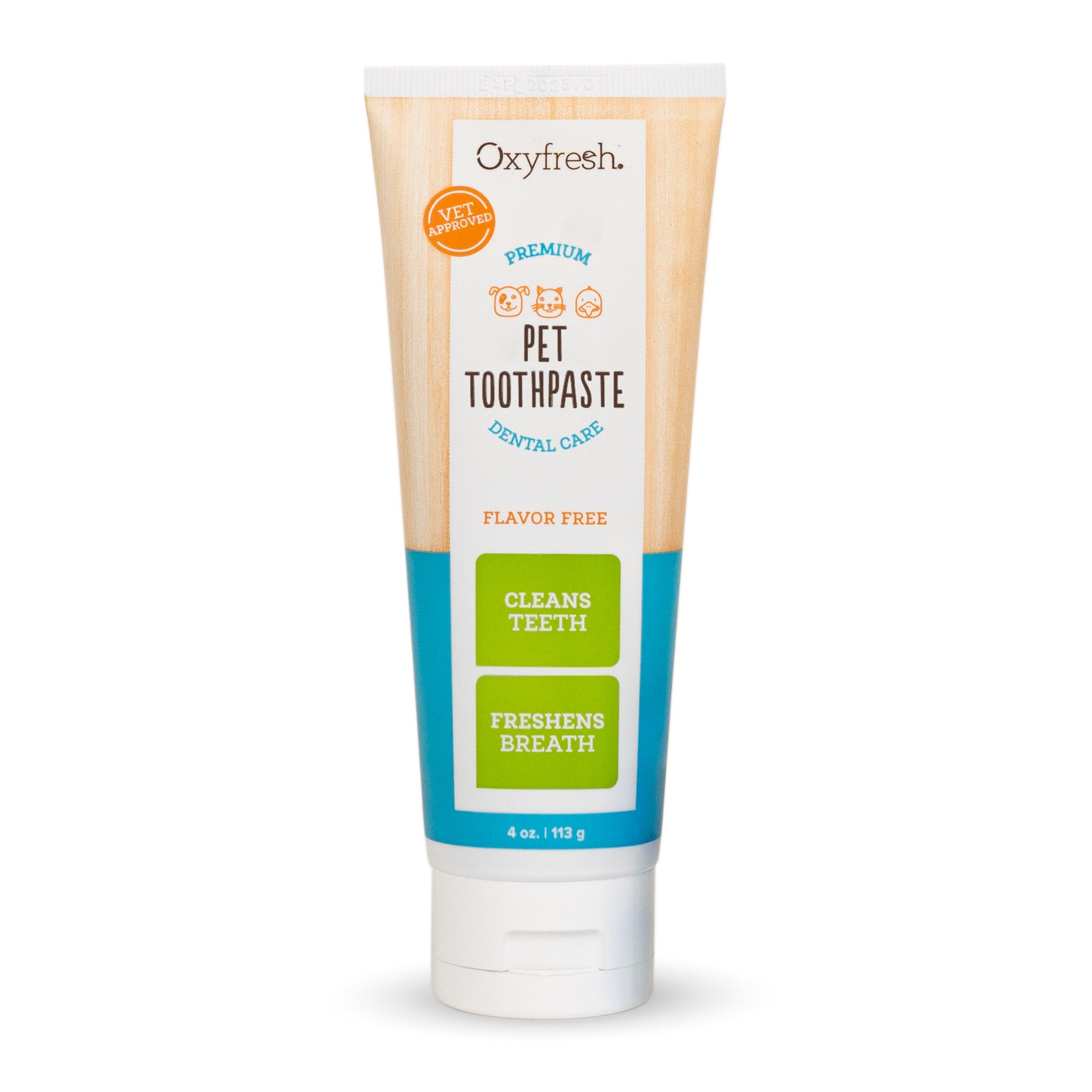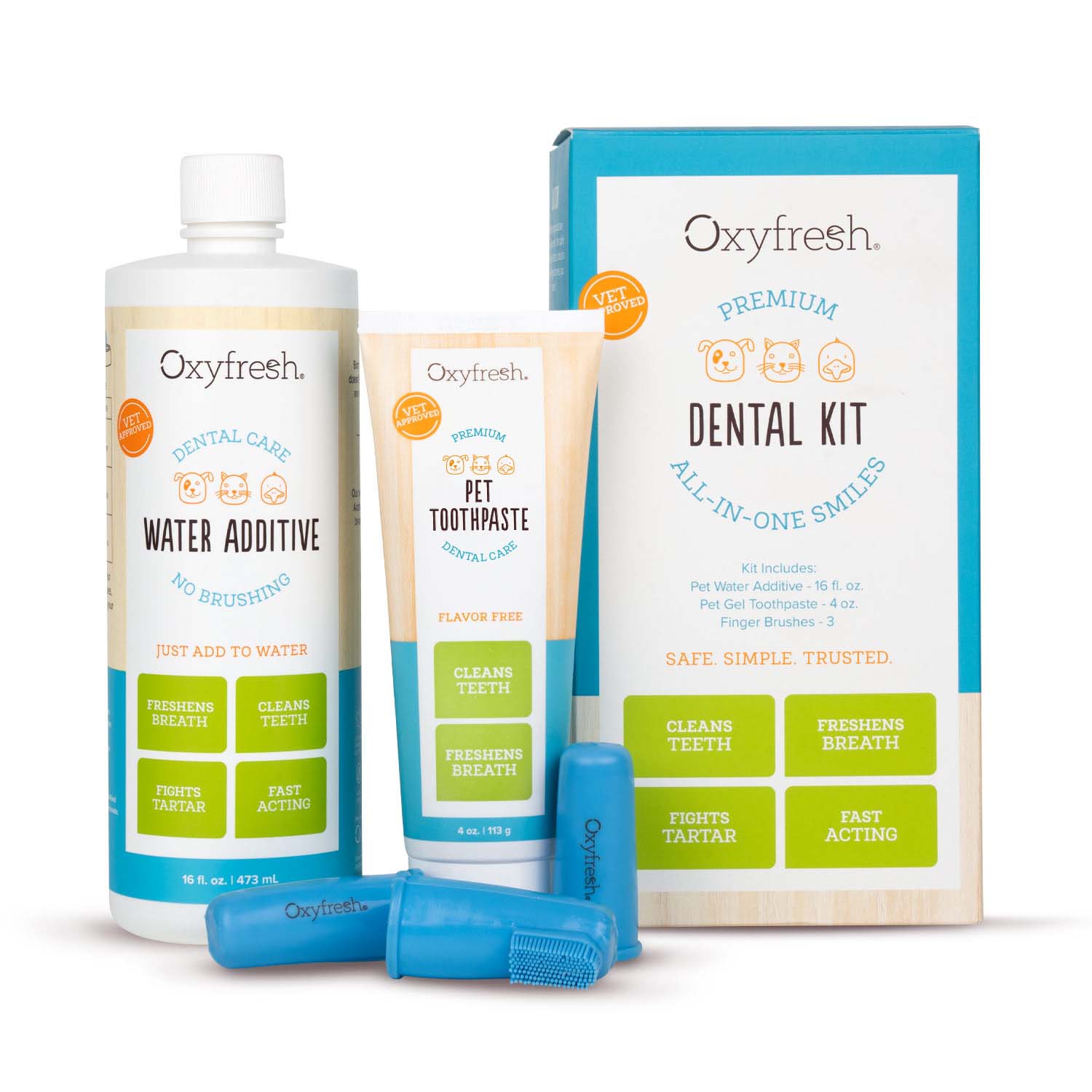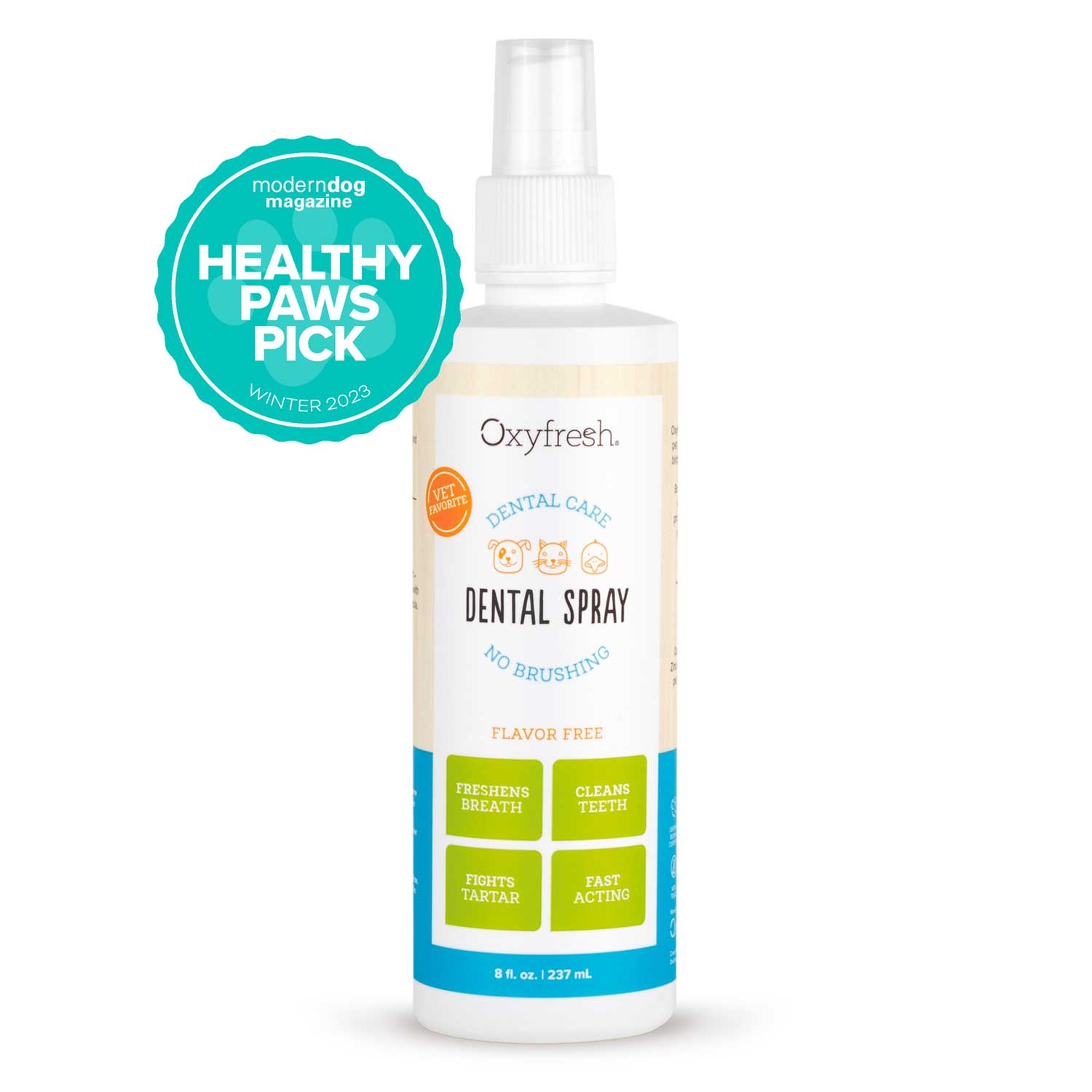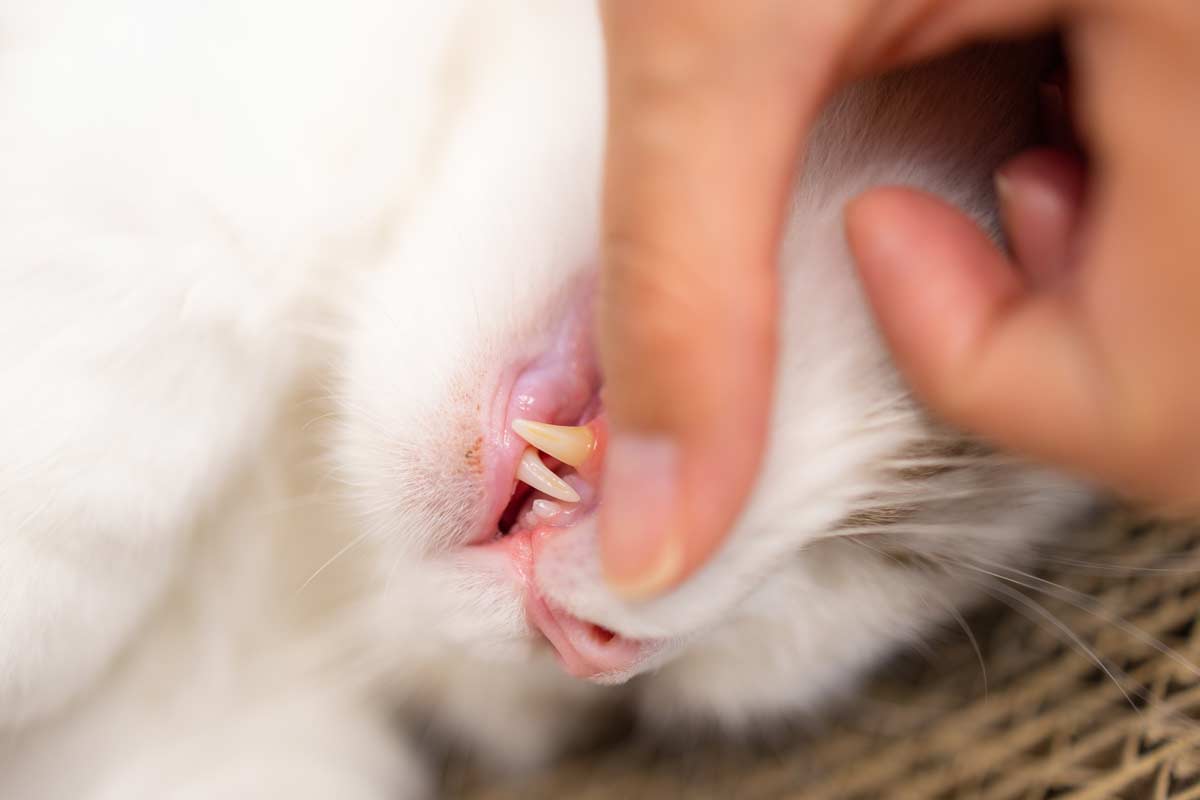Our furry friends can’t suck on a breath mint or pop a piece of gum into their mouths when they need a fresh breath pick-me-up. But they CAN sit still for a dog breath spray (well, maybe with a biscuit bribe), which begs the question: do dog mouth sprays really work?
The answer? It depends. Keep reading for everything you need to know about breath spray for dogs.
Effectiveness of Dog Breath Spray: Targeting Bacteria Is Key
If you buy a breath spray that only MASKS bad doggie breath (hello, strong mint flavors!), it won’t help to fix any oral health problems your pup is facing, and the freshness will be short-lived. However, if you get a dog breath spray that targets BACTERIA, you’re sure to see – and smell – noticeable results.
Why? Plaque (which naturally forms on the teeth after meals) and tartar are filled with harmful bacteria that grow and multiply, causing dog bad breath. If your dog’s breath is bad, it’s not something to ignore. It’s often the first sign of gum disease, which affects an astonishing 90% of dogs by age two. As gum disease progresses, it can lead to serious health consequences, from loose teeth to decreased heart function, and even shorten a dog’s lifespan by two–five years.
Dog mouth sprays that target bacteria will therefore help to freshen your dog’s breath, as well as give them essential protection against plaque, tartar and gum disease. Extra brownie points if you use a breath spray for dogs in conjunction with some other home dental routine, like brushing your dog’s teeth or putting a water additive into your dog’s water bowl daily.
Top bacteria-targeting ingredients in dog mouth spray
- Stabilized chlorine dioxide: Don’t let the word "chlorine" scare you. It’s not the same thing as regular chlorine. In fact, this oxidizing ingredient is so safe and non-toxic, it’s used to purify public drinking water and rid it of all the gross stuff, from bacteria to fungi.
- Sodium citrate: This salt of citric acid, found naturally in foods like citrus fruits and corn, helps stop the buildup of plaque and tartar while regulating pH. pH is important for healthy saliva and different systems in the body. It’s also thought to help whiten those teefers, for a best-in-show kind of smile!
- Zinc: Zinc is a safe essential trace element that aids in preventing plaque accumulation, courtesy of its antimicrobial properties. Stopping plaque from sticking to the teeth is the key to a healthy dog smile and fresh breath.
Selecting a Breath Spray for Dogs: Helpful How-Tos
- Avoid dog breath sprays with alcohol. This is not good for their overall health and can irritate their noses and throats. If your dog’s gums are already red and inflamed from plaque or tartar buildup, a blast of alcohol will not feel good.
- Rethink the baking soda. While it’s a go-to pantry staple and a great way to clean grime on the stovetop, skip the dog mouth spray with baking soda. It can lead to mild stomach upset and dogs don’t like the taste of baking soda (we can relate).
- Consider a flavor-free dog breath spray. Many dog mouth sprays contain peppermint oil. This is a strong oil, and most dogs are repelled by the scent. You want the tail wagging during dental care, not tucked between their legs!
Tips for Using a Breath Spray for Dogs
- Choose a time when your dog is chill and won’t fuss if you handle their mouth.
- Make sure to lift your dog’s lips and spray the solution along the gumline.
- If your dog is startled by the spray, you can spray it directly onto your finger and then rub it on their gums.
- Use as directed or the product could cause stomach upset if your dog ingests too much.
- Be consistent in daily use, otherwise your dog won’t reap the full benefits.
- Keep an extra bottle in the car. If you have a playdate somewhere, you don’t want your dog to be the one with bad breath.
Does Dog Breath Spray Soften Existing Tartar?
We all want a quick fix, but if your dog has heavy tartar buildup, they’ll need to start with a clean slate, meaning a professional dental cleaning, where tartar will be scraped away above and below the dog’s gum line, and then their teeth will be polished.
Pet teeth cleaning at the vet generally ranges between $500 and $1000, depending on many factors, such as where you live, the size of your dog, and if tooth extractions (removals) are needed.
Why can’t you remove tartar at home? It’s too hard (um, we’re speaking literally here). Tartar is dental plaque that has hardened onto the teeth. This process of going from plaque to tartar only takes 24 to 72 hours. That’s why stopping plaque as it forms is so important ... plaque is sticky and EASY to remove.
All dogs are susceptible to plaque and tartar buildup and gum disease, but especially small dogs and toy breeds due to teeth overcrowding. Brachycephalic breeds (dogs with short noses and flat faces like Boxers) are also more prone to gum disease.
Additional Ways to Protect Your Pup's Smile
- Maintain regular dental checkups. During your dog’s annual exam, make sure the veterinarian looks at your dog’s teeth to spot any problems like gum disease.
- Try brushing your dog’s teeth. While this process is best started when your dog is young, you CAN teach an old dog new tricks if you tackle the task with patience and preparation. For the brave souls, check out: How to Brush Your Dog’s Teeth ... Without Losing Your Sanity.
- Treat your dog to raw bones. Raw bones have plaque-fighting enzymes and mimic dental floss. Even though they don’t reach the back molars very well where plaque and tartar tend to build up the most, they’re still a tasty way to improve your dog’s oral health. (Note: if your dog has loose teeth, say no to the bones!)
- Give your dog a dental water additive. This is a completely hands-off strategy for home dental care. You just add solution into your dog’s water dish daily. But don’t waste your money on flavored water additives. Dogs don’t like to have the taste of their water messed with. Instead, try this flavor-free dog water additive.
Best Dog Breath Spray for Results You'll Be Wild About
Oxyfresh USA-made Pet Dental Spray is fast, easy and effective ... what more could you ask for in a dog dental routine? Just a few sprays and bad dog breath is sent packin’.
Our secret is targeting plaque- and bad breath-causing bacteria right at the source with a trio of trusted dental ingredients: Oxygene® (a proprietary blend of stabilized chlorine dioxide); zinc acetate; and sodium citrate. No other breath spray for dogs has this unique combo!
Rest-assured, there are no flavors like mint, cinnamon, and clove, and no baking soda, so dogs won’t turn their noses up at the taste. Simply spray along the sides of your dog’s teeth and gums, and you’re done! It’s a quick fresh breath pick-me-up for any time, anywhere!
See why Oxyfresh has been a pet dental care favorite for over 203 dog years ... get your paws on our premium dog breath spray today!




